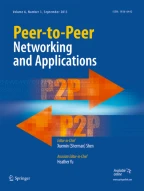Abstract
In this research, based on computing independent offloading set green communication, a mobile fusion mechanism for 5G network was indicated, to solve the problem of large-scale computing, limited resource and low utilization of 5G network. First, a 5G network architecture was designed for supporting autonomy, with the deployment of several edge terminals, multiple autonomous base stations and multiple autonomous control networks. Then, the multiple autonomous base stations were deployed evenly. Each user terminal device performs various kinds of business applications. And the information of their computing task size and resource requirements would be sent to the autonomous base station, which could autonomously control network. Secondly, to further improve the utilization of resources and reduce energy consumption, a green communication mechanism and mobile fusion mechanism were established by considering the channel characteristics and the diversity of resource status in the 5G network. Simulation results show that the proposed algorithm performs the following improvement real-time performance of 10%, throughput of 15%, convergence speed of 5%, energy efficiency and parallel computing efficiency of 8% than the reference (EURASIP J Embed Syst 2016(1):5, 2016).
Similar content being viewed by others
References
Ding Z, Liu Y, Choi J, Sun Q, Elkashlan M, I CL, Poor HV (2017) Application of non-orthogonal multiple access in LTE and 5G networks[J]. IEEE Commun Mag 55(2):185–191
Buzzi S, Chih-Lin I, Klein TE et al (2016) A survey of energy-efficient techniques for 5G networks and challenges ahead[J]. IEEE J Sel Areas Commun 34(4):697–709
Agiwal M, Roy A, Saxena N (2017) Next generation 5G wireless networks: a comprehensive survey[J]. IEEE Commun Surv Tutorials 18(3):1617–1655
Alfalahy N, Alani OY (2017) Technologies for 5G networks: challenges and opportunities[J]. IT Prof 19(1):12–20
Wu Q, Li GY, Chen W, Ng DWK, Schober R (2017) An overview of sustainable green 5G networks[J]. IEEE Wirel Commun 24(4):72–80
Chen X, Jiao L, Li W, Fu X (2016) Efficient multi-user computation offloading for Mobile-edge cloud computing[J]. IEEE/ACM Trans Networking 24(5):2795–2808
Wang F, Xu J, Wang X, Cui S (2018) Joint offloading and computing optimization in wireless powered Mobile-edge computing systems[J]. IEEE Trans Wirel Commun 17(3):1784–1797
Zhang K, Mao Y, Leng S et al (2017) Energy-efficient offloading for Mobile edge computing in 5G heterogeneous networks[J]. IEEE Access 4(99):5896–5907
Cardellini V, Valerio VD, Facchinei F et al (2016) A game-theoretic approach to computation offloading in mobile cloud computing[J]. Math Program 157(2):421–449
Tseng FH, Cho HH, Chang KD et al (2017) Application-oriented offloading in heterogeneous networks for mobile cloud computing[J]. Enterp Inf Syst:1–16
Wang J, Hu C, Liu A (2017) Comprehensive optimization of energy consumption and delay performance for green communication in internet of things[J]. Mob Inf Syst 2017:1–17
Nguyen QN, Arifuzzaman M, Sato T (2016) Proactive-caching based information centric networking architecture for reliable green communication in intelligent transport system[C]. 2015 ITU Kaleidoscope: Trust in the Information Society (K-2015). IEEE:1–7
Pandey B, Pandey N, Kaur A et al (2018) Scaling of output load in energy efficient FIR filter for green communication on ultra-scale FPGA[J]. Wirel Pers Commun:1–14
Amamou L, Boujelben M, Besbes H (2017) Transmit power mitigation in cooperative green communication[C]// wireless communications and Mobile computing conference. IEEE:329–333
Abrol A, Jha RK, Jain S, Kumar P (2018) Joint power allocation and relay selection strategy for 5G network: a step towards green communication[J]. Telecommun Syst 68(2):201–215
Liu X, Zhang X, Jia M, Fan L, Lu W, Zhai X (2018) 5G-based green broadband communication system design with simultaneous wireless information and power transfer[J]. Phys Commun 28:130–137
Wang S, Zhang X, Zhang Y, Wang L, YANG J, Wang W (2017) A survey on Mobile edge networks: convergence of computing, caching and communications[J]. IEEE Access 5(99):6757–6779
Kani J (2017) Solutions for future Mobile Fronthaul and access-network convergence[J]. J Lightwave Technol 35(3):527–534
Ruffini M (2017) Multidimensional convergence in future 5G networks[J]. J Lightwave Technol 35(3):535–549
Srivastava JV, Finger M (2017) Fixed to Mobile convergence (FMC) technological convergence and the reconfiguration in the organization of the European telecommunications industry[J]. Int Rev Neurobiol 87(6):47–79
Jin Y, Dai H, Sui C, Liu A, Xu P (2016) Opportunity cooperative embedded platform and control mechanism based on selectivity of time and frequency domain[J]. EURASIP J Embed Syst 2016(1):5
Author information
Authors and Affiliations
Corresponding author
Additional information
This article is part of the Topical Collection: Special Issue on Fog/Edge Networking for Multimedia Applications
Guest Editors: Yong Jin, Hang Shen, Daniele D'Agostino, Nadjib Achir, and James Nightingale
Publisher’s Note
Springer Nature remains neutral with regard to jurisdictional claims in published maps and institutional affiliations.
Rights and permissions
About this article
Cite this article
Shu, Y., Zhu, F. Green communication mobile convergence mechanism for computing self-offloading in 5G networks. Peer-to-Peer Netw. Appl. 12, 1511–1518 (2019). https://doi.org/10.1007/s12083-018-0704-7
Received:
Accepted:
Published:
Issue Date:
DOI: https://doi.org/10.1007/s12083-018-0704-7
